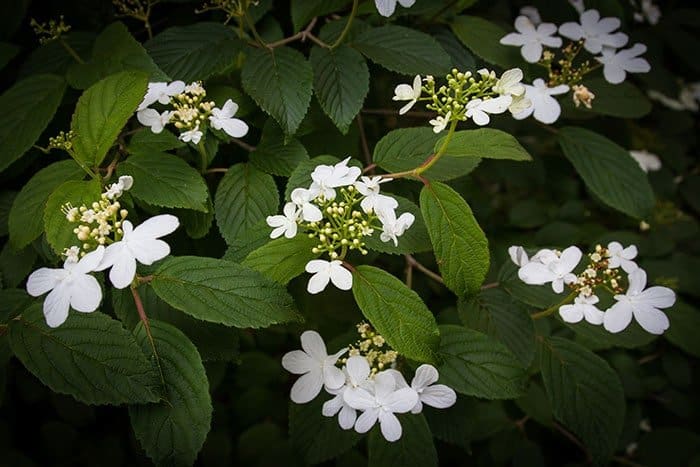
One of the benefits of taking down a large tree in the front garden has been the increased sunlight for plants growing in the area. Everything is bigger and blooming with more flowers! One shrub that’s enjoying more sun is ‘Summer Snowflake’ viburnum (Viburnum plicatum f. tomentosum ‘Summer Snowflake’, Zone 6, 5 x 4 feet / 1.5 x 1.2 m). This is a doublefile viburnum, meaning it has two opposing lines of white flowers marching along its layered, pagoda-style branches. ‘Summer Snowflake’ is more upright and compact than other doublefile viburnums, such as ‘Lanarth’, ‘Mariesii’ and ‘Shasta’. It fits into small gardens, and is a good partner in mixed borders with perennials. ‘Summer Snowflake’ provides a constant show of white flowers, and works as a foil to brighter and darker perennials blooming sequentially through summer.
Aside from its smaller size, ‘Summer Snowflake’ is similar to other doublefile viburnums in almost every respect. It has the same layered form, abundant flowers, drupes of red fruits turning to black (relished by birds), and reddish to bronze-purple fall colour. But it has one great advantage: an ability to produce flushes of flowers from May through October. I’ve experimented with the amount of light necessary to sustain a long season of flowering, and it’s no surprise that the more direct sunlight this shrub gets, the better it blooms. In light shade, it carries only a handful of flowers at any time, however, in four to six hours of sun the shrub blooms generously most of the growing season. Placed in full sun, I’m sure it would be luxuriant with bursts of flowers through the summer.
My only hesitation about ‘Summer Snowflake’ is its borderline cold hardiness, although that isn’t currently a problem. My first shrub was planted about 12 years ago, in the bad old days when my Zone 6a garden would sometimes fall under a temporary cold snap and be more like Zone 5b. That shrub died in a winter cold spell that dipped below normal limits. My garden is warmer now, and borderline hardy plants that once perished here — fragrant winterhazel (Corylopsis glabrescens, Zone 6), to name one — are now surviving and have become well established.
The first doublefile viburnum was procured from a Shanghai garden in 1850 by Robert Fortune, one of the adventurous 19th-century plant hunters. Doublefile viburnums are known for their abundance of bloom, often smothered in flowers when at their peak. Most flowering shrubs bloom three to six weeks, and bloom time can be lengthened in a cool spring or shortened by sudden heat. But ‘Summer Snowflake’ just keeps on flowering regardless of temperature, and gives much pleasure while maintaining a reasonable size. I have two in the front garden, and this year they’re enjoying more light than ever before. And I’m enjoying more flowers!

My experience with viburnum summer snowflake is that while more light has meant more blooms the leaves have scorched in the high sun of summer. So I have fresh bright blossoms on Sept 2 against reddish brown leaves.
I have just bought a viburnum summer snowflake. It did not have the size on it and I don’t have a suitable site for it. Would it thrive in a large pot as well as restricting its size? Would be grateful if someone has experienced doing this or knows if it is successful.
Many thanks.
Does anybody has experince with growing viburnum summer snowflake in big planters? I would use them for a privacy screen.
Thanks
Hi Louise,
Thanks so much for sharing your experience with ‘Summer Snowflake’ viburnum. I learned something — that it needs a few winters and a wind barrier to adapt in a borderline hardiness zone. And what’s more, the tip about deadheading spent blooms to keep it flowering. I didn’t think of that, and this year will certainly remove the spent flowers. Thanks for your advice!
— Judith
I just wanted to share my experience with the ‘Summer Snowflake’ viburnum. When we lived in Palmerston, Ontario, our wee wartime bungalow had 3 huge Holmstrup cedars on the west side of the house. To brighten up this location, I planted one between each cedar. The winter wind whipped through the houses and I’m sure our Zone 5b turned into a 5a or maybe even colder. I put up a cardboard barrier the first winter in front of each of them. The second winter I didn’t and quite a bit died back – at least by half. By the third winter they were doing fine and by the fourth, they were 5 ft. tall. I find that as long as you continually deadhead them, they are quite floriferous and then the bonus of fall colour is stunning. If I could attach a photo of that garden here, I would. We have since moved to Elmira, Ontario, and I just planted one in the front garden, which faces northwest. I’ll be curious to see how it fares come next spring!
Cheers, Louise